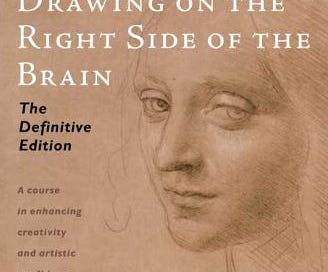Drawing on the Right Side of the Brain
Learning to engage our right brain through an art practice can bring us relief from chaos
“As a number of scientists have noted, research on the human brain is complicated by the fact that the brain is struggling to understand itself. This three-pound organ is perhaps the only bit of matter in the (sic) our universe—at least as far as we know—that observes and studies itself, wonders about itself, tries to analyze how it does what it does, and tries to maximize its capabilities. This paradoxical situation no doubt contributes to the deep mysteries that still remain despite rapidly expanding scientific knowledge. One of the most encouraging new discoveries that the human brain has made about itself is that it can physically change itself by changing its accustomed ways of thinking, by deliberately exposing itself to new ideas and routines, and by learning new skills. This discovery has led to a new category of neuroscientists, neuroplasticians, who use microelectrodes and brain scans to track complex brain maps of neuronal communication, and who have observed the brain revising its neuronal maps.
This conception of a plastic brain, a brain that constantly changes with experience, that can reorganize and transmute and even develop new cells and new cell connections, is in direct contrast to previous judgments of the human brain as being more akin to a hard-wired machine, with its parts genetically determined and unchangeable except for development in early childhood and deterioration in old age. For teachers like myself, the science of brain plasticity is both exciting and reaffirming—exciting because it opens vast new possibilities, and reaffirming because the idea that learning can change the way people live and think has always been a goal of education. Now, at last, we can move beyond the ideas of fixed intelligence limits and special gifts for the lucky few, and look for new ways to enhance potential brain power.”
Excerpt from
I've always been fascinated by contemplating the nature of our existence. Reflecting on what it means to be alive, to be in this human form, at this time in the entire history of the universe and our particular place in it, leads me to appreciate the marvel of it all.
As Betty Edwards points out in her book, Drawing on the Right Side of the Brain, “This three-pound organ is perhaps the only bit of matter in the (sic) our universe… that observes and studies itself, wonders about itself, tries to analyze how it does what it does”. The appeal of this is book is that she not only talks about methods of drawing, but also explores how we perceive, the psychology and physiology of perception, and how engaging our faculties of vision and manual dexterity can revitalize our experience of the world.
When we engage in the process of representational drawing—or any representational art form—the practice of looking at the world as it is, is just as important as the skill of drawing itself. When we're looking carefully from frameworks that are new to us, the brain can shift from being centered on the left hemisphere, which is primarily the locus of language and rational thinking, to the right hemisphere, which functions more to perceive the gestalt and the visual environment. This shift can bring us a sense of calm or joy similar to when we see a beautiful sunset. This change in our experience is what Edwards calls entering the ‘R-mode’.
For me, my intention to enter the R-mode is more important than attempting to master an artistic skill. While learning these skills is important for making representational art, the practice of bringing increased awareness to our visual perception will lead to a completely different, more satisfying experience of being alive.
How to balance these two modes? This is what I focus on in my coaching sessions. They are designed to cultivate new habits of reflective perception of the world, and then transfer those perceptions onto a two-dimensional surface. This potential is open to everyone. And as Betty Edwards says, “We don't need particular skills to learn how to draw”.




